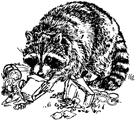Eastern Wildlife Damage Control Conferences

Eastern Wildlife Damage Control Conference: 5th (1991)
Date of this Version
February 1991
Document Type
Article
Abstract
Jersey, an experimental deer repellent, was field tested against 2 commercial repellents on Japanese yews (Taxuscuspidata) near Ithaca, New York, during spring 1990. In Experiment 1, plots (nnn = 24) of 4 individually-potted yews were established, with 2 yews at each plot randomly treated with Jersey and 2 left as controls. Plots of 4 (1 x 4, n nn =12) and 16 (4 x 4, nnn = 2) plants were used in Experiment 2, with individual plants being treated with Jersey, Hinder”, or Big Game RepellentR (BGRR) or left as controls. Photographs with a grid matrix placed behind each h plant were taken from 2 m at the beginning of the experiment and after 10 weeks. These photographs were analyzed to produce a cover index of plant size. Plots were monitored weekly to record browsing. In Experiment 1 more control (46/48) than treated (7/48)plants were browsed (P < 0.001). Controls were browsed earlier (x =1.7 wk) than treated yews (x = 4.4 wk, P < 0.01). At the end of 10 weeks, control plants were reduced in size more than Jersey-treated plants (P < 0.001). In Experiment 2, browsing rates did not differ among treatments in the 1 x 4 plots or 4 x 4 plots. However, controls were browsed more frequently than treated at both plot types (10/12 at 1 x 4, and 6/8 at 4 x 4 plots) (P < 0.05). Browsing reduced control plants by 56.8% (n =10) in 1 x 4 plots and 47.2% (n = 6) in 4 x 4 plots. These results suggest that Jersey reduced deer damage to a shrub preferred by deer. Moreover, Jersey was as effective as BGRR and Hinder" at reducing browsing. Experiments may need to be conducted under more severe conditions and over a longer time-period to separate efficacy of the 3 repellents.

